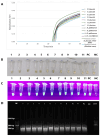Development of an RT-LAMP Assay for Detecting tet(M) in Enterococcus Species: Enhancing AMR Surveillance Within the One Health Sectors
- PMID: 40428207
- PMCID: PMC12109771
- DOI: 10.3390/diagnostics15101213
Development of an RT-LAMP Assay for Detecting tet(M) in Enterococcus Species: Enhancing AMR Surveillance Within the One Health Sectors
Abstract
The increasing prevalence of antimicrobial-resistant (AMR) bacteria in humans, animals, and the environment underscores the necessity for a rapid, sensitive, and specific method to identify resistance genes. Objectives: This study aims to develop a reliable detection tool for identifying the tetracycline-resistant gene tet(M) in Enterococcus species using a real-time loop-mediated isothermal amplification (RT-LAMP) assay. Real-time visualization through a turbidimeter enabled precise estimation of time-to-positivity for gene detection. Methodology: Six primers were designed using PrimerExplorer v.5, and the assay was optimized across different temperatures and incubation times. Validation was conducted by testing 52 tet(M)-positive clinical enterococci isolates and spiking urine samples from a healthy volunteer and a cow with tet(M)-positive Enterococcus species. Results: The tet(M) gene was detected as early as 33 min, with optimal amplification occurring within 60 min at 60 °C. The assay demonstrated 100% specificity with the established primers. The sigmoidal graphs were corroborated with visual confirmation methods, including a green color change (visible to the naked eye), green fluorescence (under UV light), and a 200 bp PCR product observed via agarose gel electrophoresis. Notably, the tet(M) RT-LAMP assay exhibited a detection limit of 0.001 pg/μL, significantly surpassing conventional PCR, which had a detection limit of 0.1 pg/μL. Conclusions: This rapid, cost-effective, highly sensitive, and specific tet(M) RT-LAMP assay holds significant promise as a surveillance tool for antimicrobial resistance monitoring within a One Health framework, particularly in low-resource countries.
Keywords: One Health; RT-LAMP; antimicrobial-resistant; enterococci; tet(M); tetracycline resistance.
Conflict of interest statement
The authors declare no conflicts of interest.
Figures







Similar articles
-
One-step single-tube accelerated quantitative nucleoprotein gene-specific reverse transcription loop-mediated isothermal gene amplification (RT-LAMP) assay for rapid, real-time & reliable clinical detection of Ebola virus.Indian J Med Res. 2021 Apr;154(4):598-606. doi: 10.4103/ijmr.IJMR_864_19. Indian J Med Res. 2021. PMID: 35435345 Free PMC article.
-
Real-time reverse transcription loop-mediated isothermal amplification for rapid detection of West Nile virus.J Clin Microbiol. 2004 Jan;42(1):257-63. doi: 10.1128/JCM.42.1.257-263.2004. J Clin Microbiol. 2004. PMID: 14715762 Free PMC article.
-
[Detection of measles virus genome by reverse transcription-loop mediated isothermal amplification(RT-LAMP)].Zhonghua Liu Xing Bing Xue Za Zhi. 2014 Feb;35(2):186-9. Zhonghua Liu Xing Bing Xue Za Zhi. 2014. PMID: 24739562 Chinese.
-
Development of Reverse Transcription Loop-Mediated Isothermal Amplification for Rapid Detection of Batai Virus in Cattle and Mosquitoes.Vector Borne Zoonotic Dis. 2016 Jun;16(6):415-22. doi: 10.1089/vbz.2015.1882. Epub 2016 Mar 30. Vector Borne Zoonotic Dis. 2016. PMID: 27027481
-
Sensitive and rapid detection of tet(X2) ~ tet(X5) by loop-mediated isothermal amplification based on visual OTG dye.BMC Microbiol. 2023 Nov 6;23(1):329. doi: 10.1186/s12866-023-02944-4. BMC Microbiol. 2023. PMID: 37932695 Free PMC article.
Cited by
-
White Light Spectroscopy for Sampling-Free Bacterial Contamination Detection During CAR T-Cells Production: Towards an On-Line and Real-Time System.Biosensors (Basel). 2025 Aug 6;15(8):512. doi: 10.3390/bios15080512. Biosensors (Basel). 2025. PMID: 40862971 Free PMC article.
References
-
- Makarov D.A., Ivanova O.E., Pomazkova A.V., Egoreva M.A., Prasolova O.V., Lenev S.V., Gergel M.A., Bukova N.K., Karabanov S.Y. Antimicrobial resistance of commensal Enterococcus faecalis and Enterococcus faecium from food-producing animals in Russia. Vet. World. 2022;15:611–621. doi: 10.14202/vetworld.2022.611-621. - DOI - PMC - PubMed
-
- Iancu A.-V., Arbune M., Zaharia E.-A., Tutunaru D., Maftei N.-M., Peptine L.-D., Țocu G., Gurău G. Prevalence and Antibiotic Resistance of Enterococcus spp.: A Retrospective Study in Hospitals of Southeast Romania. Appl. Sci. 2023;13:3866. doi: 10.3390/app13063866. - DOI
LinkOut - more resources
Full Text Sources

